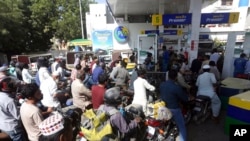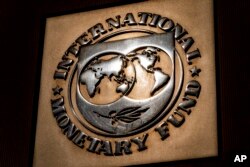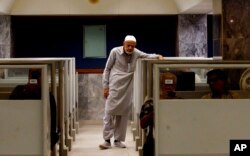The executive board of the International Monetary Fund is slated to convene Monday to decide whether to disburse over $1 billion in loans to Pakistan. The move will unlock critically needed additional foreign funding as the country struggles to avoid economic collapse amid high inflation and low foreign exchange reserves.
While Pakistan’s economic woes are nothing new, experts say its strategic significance compels global powers to keep this nuclear-armed South Asian nation of almost 230 million people afloat.
How poor is Pakistan’s economy?
The Pakistani currency, the rupee, lost more than a third of its value and hit an all-time low against the U.S. dollar in July before rebounding a bit. Year-over-year inflation touched a painful 25%, according to government data released in July, with prices of staples like cooking oil and lentils almost doubling.
Earlier the government banned imports of more than three dozen “nonessential” or “luxury” items including canned fish, jams and jellies. A government minister famously urged people to “drink less tea” as the rising import bill, coupled with a lack of foreign funding, ate away at the country’s foreign exchange reserves.
According to the State Bank of Pakistan, the central bank’s foreign exchange reserves stood below $8 billion in mid-August, barely enough to cover a few weeks’ worth of imports.
Government officials blame the country’s economic woes on the global rise in the cost of food and fuel because of supply chain issues caused by the COVID-19 pandemic and Russia’s war in Ukraine.
Uzair Younus, director of the Pakistan Initiative at the Atlantic Council's South Asia Center, said in an interview, “Pakistan’s COVID strategy on the health and economic side was perhaps the best in the region ... [but] the amount of stimulus and amnesties that were given were just enormous, and so a lot of import spending went out as a result of that.”
The country relies heavily on foreign loans and imports. Government data show its total external debt — the money it owes other countries and foreign lenders — is more than 80% of its GDP.
Why Pakistan’s economic stability matters
Standing on the brink of default, Pakistan managed in the last six weeks to secure loans, financing, deferred oil payments and investment commitments close to $12 billion from China, Saudi Arabia, Qatar and UAE. However, much of this and more from other multilateral lenders such as the World Bank will become available only after the IMF board approves the release of almost $1.2 billion.
Younus believes the optics of a Pakistan in peril are particularly poor for China, which is anxious for the success of its global infrastructure project, the Belt and Road Initiative (BRI).
“If the BRI is the poster child of China’s foreign and economic policy globally, that shows China has arrived, then CPEC was its crown jewel in so many ways,” he told VOA, referring to the China-Pakistan Economic Corridor, an almost $60 billion collection of infrastructure development projects funded by Chinese loans and investments in Pakistan.
“If [Pakistan] goes belly up and defaults, that will really raise questions about China’s own ability to set up competing infrastructure, competing financial instruments, et cetera ... for its own strategic partners,” Younis said. In that event, “the contagion effect of Pakistan’s economic collapse on broader Chinese foreign policy, economic policy, would be too big.”
Tamanna Salikuddin, director of South Asia programs at the United States Institute of Peace, said the “U.S. tap [has] much more dried up” over the last 20 years as the war in Afghanistan dragged on.
However, she said, Washington still supports the loans through the IMF, where it is the biggest donor, because “a crisis on Afghanistan’s border is not something that the U.S. wants to see. ... Counterterrorism interests and nuclear security and stability remain in U.S. national security interests.”
As the competition for global influence between Beijing and Washington heats up, Salikuddin said, Pakistan can position itself in the middle and ensure that it “certainly gets bailed out.”
Why Pakistan needs repeated bailouts
Pakistan is among the world’s most bailed-out countries. It is currently participating in its 23rd loan program with the IMF since the country joined the institution in 1950, just three years after partition from India.
Successive governments have promised to “break the beggar’s bowl” or get the country out of IMF’s “trap,” but experts note a consistent lack of political will and public appetite for necessary economic reforms. In a nation of almost 230 million, fewer than 3 million file income tax returns, according to government data. Any efforts at expanding the tax net are met with severe opposition.
The latest disbursement to be decided on by the IMF board Monday is, in fact, part of a $6 billion loan program agreed upon with Islamabad in 2019. If approved, the money will come after months of delays and tough negotiations as Pakistan backtracked on promised policy reforms.
Younis applauded the new government that took over in May for its willingness to make some tough choices like raising taxes on fuel and electricity and reducing government subsidies after a few reversals but sees no signs of long-term reform.
What’s next for Pakistan?
Lifting the ban on most “luxury” imports at the end of last month, Finance Minister Miftah Ismail assured a late-night news conference that Pakistan would not default. However, political wrangling at home may still derail plans with the IMF.
Experts VOA spoke to noted that Pakistan’s economy is broad and deep and its geostrategic position strong enough for it to avoid default.
However, Salikuddin said, it’s partially this geostrategic importance that leads Pakistan to make “irresponsible” economic policies as the leadership perhaps believes the country is “too big to fail.”











